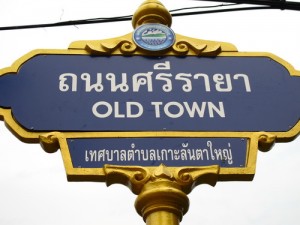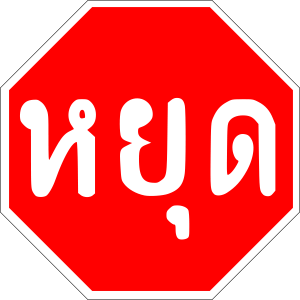I don’t usually go for blatant advertising on this site, but I am going to make my first exception in this case! For anyone interested in learning Thai and hasn’t quite decided which route to follow, the High Speed Thai course is a good choice. I ordered it a few months ago, and have been working away at it fairly regularly for about an hour per day, which isn’t that much compared to some people, apparently. And, yes, if anyone purchases the course by clicking one of the links on this page, I make a small commission.
 Over the years, I have taken several language courses, both on my own and in classroom settings. Growing up in Quebec, we had to study French from Grade 3 until the end of high-school. Upon graduation, most of us still could not carry on a conversation in French to any degree that would be useful in real life! I continued my French studies as an elective course while pursuing my Chemistry degree but found that the pace of learning was still a little fast for what I was ready for at that point. I did learn the basics after all this classroom instruction but most of my actual conversational skill were acquired outside the classroom.
Over the years, I have taken several language courses, both on my own and in classroom settings. Growing up in Quebec, we had to study French from Grade 3 until the end of high-school. Upon graduation, most of us still could not carry on a conversation in French to any degree that would be useful in real life! I continued my French studies as an elective course while pursuing my Chemistry degree but found that the pace of learning was still a little fast for what I was ready for at that point. I did learn the basics after all this classroom instruction but most of my actual conversational skill were acquired outside the classroom.
Ditto for Chinese. While living in China, my wife and I ended up taking a free Chinese course that was being offered to the teachers at our school. Again, the pace was quite fast and the class was only offered once a week, so a lot of the learning and lesson review had to occur outside of class time on our own.
The nice thing about High Speed Thai is that you always have the lessons and the teacher with you! You can move through it at your own pace and stay in one lesson long enough to learn it thoroughly before moving on. The other great thing is that the alphabet, tones, and sounds are taught before any vocabulary is introduced. You learn how to read and write Thai before learning how to speak it. You can go as fast or slow as you want, depending on how much time you are prepared to spend on it each day.
 Thai, like English, is a phonetic language. Once you have learned the alphabet and the sounds, it is not a big step to sound out words that you see. Some say they don’t really care if they can read it; they just want to be able to speak it. Well, I love the fact that I can now walk around Chiangmai and try to read and understand all the signs. The best signs are the ones that are in Thai and English. It is a way to constantly practice what you have learned!
Thai, like English, is a phonetic language. Once you have learned the alphabet and the sounds, it is not a big step to sound out words that you see. Some say they don’t really care if they can read it; they just want to be able to speak it. Well, I love the fact that I can now walk around Chiangmai and try to read and understand all the signs. The best signs are the ones that are in Thai and English. It is a way to constantly practice what you have learned!
Unlike Chinese, Thai has no universally accepted transliteration into English. Everything you see will be a little different. If you can read the Thai letters and understand their sounds, it is a lot easier to learn new words and phrases. I haven’t spent a lot of time practicing writing the language but would like to eventually do that.
The amount of information that comes with this course is phenomenal. The foundation of the course is a huge PDF book that contains over 1000 pages and over 80 comprehensive lessons. And when I say comprehensive, I mean it. I have easily spent two or three hours on some of the lessons before I feel like they have mastered. I can’t believe how much work must have gone into putting this course together.
The High Speed Thai “book” contains links to hundreds of sound files (more than 70 hours of audio by a native speaker) that lead you through the pronunciation and vocabulary lessons. Each lesson includes a review section, vocabulary section and reading for understanding. The amount of material at your fingertips is enough to keep you busy for a very long time. The nice part is that you can go back and review any section whenever you want or skip ahead and learn some new vocabulary that you might be interested in right now.
The course starts with an introduction to grammar, pronunciation, tones and a very general look at the Thai alphabet. After several detailed lessons on the Thai alphabet and reading, it proceeds to time and numbers. This is followed by forty vocabulary lessons and ends with several lessons that revolve around a series of Thai contemporary TV and video excerpts.
As an ex-teacher and experienced student, I know that classroom instruction can have its downfalls. The teacher can move too slowly or too quickly through the material, there can be a wide span of previous knowledge and experience among the students, and the information being taught may not be that useful. In addition, classes can be expensive.
The total cost of High Speed Thai is $220 which is not a lot of money for this amount of resources and lessons. Here in Chiangmai, the cost of private lessons ranges from 350 – 350 baht per hour. Classroom units of instruction range from 4000 – 5000 baht per course. The High Speed Thai program is equivalent to several courses from beginner to advanced. Vincent, who wrote the course and owns the company, is very helpful if you have any technical problems with any part of the course.
The only negative thing I can see is that you have to be committed to spend time on this each day. Being in a class gives you motivation to show up, especially if you are learning in a group. But if you really are serious about learning the language, and are willing and motivated to put in the time, I can highly recommend this program. I don’t think you will be disappointed.



Great blog Steve! I still enjoy reading it and although I doubt I will be able to visit Asia again, I still get happy memories when you tell of your life in Thailand. Did you make it through the heat of summer without thinking of a Canadian winter?
Keep on writing and hugs for Nancy!
Hi Merrilyn! Yeah, the heat in Chiangmai is not that bad after living in Wuhan for six years! We’ve only turned on the AC a couple of times at night since we moved here over two months ago. In fact, the only place we have AC is in the bedroom. It’s in the mountains so doesn’t get as hot as Bangkok and other places further south.